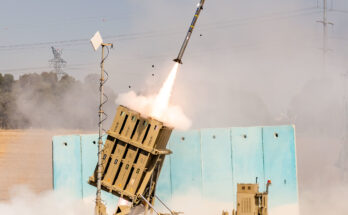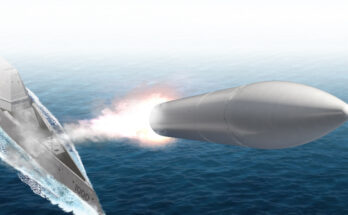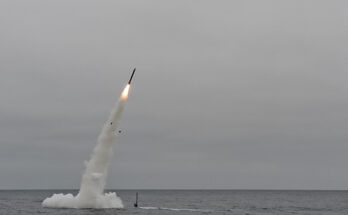by Larry Dickerson, Missile Systems Analyst, Forecast International.
In its recently updated “The Market for Strike Missiles” analysis, Forecast International notes the steadily increasing use of precision-guided munitions in military operations. During Operation Desert Storm, PGMs made up only 10 percent of the total air-launched weapons used. The figure increased to 31 percent after the United States launched Operation Iraqi Freedom (2003). The use of PGMs reached a pinnacle during NATO’s air campaign over Libya in 2011: 100 percent of the munitions expended were precision guided.
Operation Unified Protector saw the first large-scale use of the MBDA-built SCALP, Storm Shadow, and Brimstone, and Sagem’s Armement Air-Sol Modulaire (AASM). In addition, the PGM-500 Hakim missile was first used during this conflict. MBDA developed this missile for the United Arab Emirates, which sent Mirage 2000-9 fighters to support the NATO-led operation.
During the Libyan air campaign, NATO aircraft flew over 26,000 sorties, including more than 9,600 strike missions. Now, many of these weapons are striking targets in Iraq and Syria. The U.S. and its allies began a new air campaign after Islamic State militants overran large parts of both countries.
The use of armed unmanned air vehicles (UAVs) in these operations is fueling demand for a new generation of lightweight missiles. The U.S. was first to deploy this new type of missile, in support of its air campaign against militants hiding in Pakistan’s tribal regions. Other countries soon followed. More new lightweight missiles will arrive in the future.
The heavy use of PGMs by the United States and its allies during combat operations is helping to focus attention on standoff attack missiles. Whether this will mean an increase in annual procurement remains to be seen, but the numbers are heading up.
The number of countries around the world showing interest in acquiring strike missiles is steadily growing. China and Taiwan are well known for tit-for-tat missile development projects. Taiwan’s state-run National Chung Shan Institute of Science and Technology is providing missiles with sufficient range to strike an ever-increasing portion of mainland China. Now, Taiwan has begun production of the Wan Chien.
More recent additions to this market are Brazil, India, South Africa, South Korea, and Turkey. India sees joint ventures lessening its dependence on foreign arms suppliers. South Korea is slowly expanding the capability of its strike missiles, and Turkey could begin production of a new system in the very near future.
Recent military operations across the Middle East and in Asia have shown the limitations of long-range strike missiles. These weapons can destroy a designated target, but it takes infantry to take and hold ground. NATO air strikes stopped Col. Muammar al-Qadhafi from crushing the Libyan rebellion, but combat aircraft could not win the war for the rebels.
The long-range strike missile market overall is worth $17.2 billion over the next 10 years and will involve the production of more than 54,000 missiles. Within this market are missiles capable of striking a wide variety of targets, including air defense systems.
Anti-radiation missiles remain an under-recognized weapon in this market. These weapons were among the first used during operations in Iraq and Libya. Demand for ARMs has always been restricted, and they are produced in far fewer numbers than other types of missiles. Nevertheless, money is being invested to create new ARMs to deal with air defense systems that are more capable than ever. Through 2025, companies will build more than 9,000 ARMs, generating $2.8 billion in value.
Also, this market contains a growing number of lightweight missiles, initially developed for use from unmanned aircraft. The United States, China, Israel, and France have active production lines, with South Africa, Taiwan, and others likely to follow suit. Although production will exceed 19,000 missiles, the value created is just $1.2 million.
Since the end of the Cold War, the strike and anti-ship missile markets have been experiencing an evolution. Advances in technology now allow a single weapon to perform both anti-shipping and strike missions, blurring the market for these types of missiles. In a few years, the anti-ship and anti-radiation missile markets could become submerged in a larger strike weapons market. This might also be the case with lightweight missiles and some part of the guided rocket market.
Please feel free to use this content with Forecast International and analyst attributions, along with a link to the article. Contact Ray Peterson at +1 (203) 426-0800 or via email at ray.peterson@forecast1.com for additional analysis.
 FI’s Missile Forecast provides extensive coverage of the worldwide market for tactical and strategic missiles, both developmental and in production. With 120+ individual reports, Missile Forecast examines the forces that have led to the dominance of the top manufacturers in this segment, identifies new market competitors, and traces the evolution of new products. Five Analyses (Strike, Air-to-Air, Anti-Ship, Surface-to-Air, and Anti-Tank) examine the economic, financial, and political factors driving individual market segments.
FI’s Missile Forecast provides extensive coverage of the worldwide market for tactical and strategic missiles, both developmental and in production. With 120+ individual reports, Missile Forecast examines the forces that have led to the dominance of the top manufacturers in this segment, identifies new market competitors, and traces the evolution of new products. Five Analyses (Strike, Air-to-Air, Anti-Ship, Surface-to-Air, and Anti-Tank) examine the economic, financial, and political factors driving individual market segments.
For 50 years, Forecast International intelligence reports have been the aerospace and defense industry standard for accurate research, analysis, and projections. Our experienced analysts compile, evaluate, and present accurate data for decision makers. FI's market research reports offer concise analysis of individual programs and identify market opportunities. Each report includes a program overview, detailed statistics, recent developments and a competitive analysis, culminating in production forecasts spanning 10 or 15 years. Let our market intelligence reports be a key part of reducing uncertainties and mastering your specific market and its growth potential. Find out more at www.forecastinternational.com




